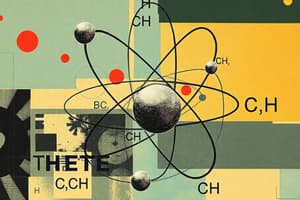Podcast
Questions and Answers
Which particle in the atom carries a positive charge?
Which particle in the atom carries a positive charge?
- Electron
- Proton (correct)
- Photon
- Neutron
What type of bond is formed when electrons are shared between atoms?
What type of bond is formed when electrons are shared between atoms?
- Ionic bond
- Metallic bond
- Hydrogen bond
- Covalent bond (correct)
Which of the following is a characteristic of polar molecules?
Which of the following is a characteristic of polar molecules?
- They contain only nonpolar covalent bonds.
- They tend to dissolve in nonpolar solvents.
- They have a uniform charge distribution.
- They can form hydrogen bonds with water. (correct)
Which macromolecule is primarily responsible for storing energy?
Which macromolecule is primarily responsible for storing energy?
What happens during dehydration synthesis?
What happens during dehydration synthesis?
Which fatty acid type contains at least one double bond in its structure?
Which fatty acid type contains at least one double bond in its structure?
Which component is NOT part of an amino acid structure?
Which component is NOT part of an amino acid structure?
What factors can influence an enzyme's activity?
What factors can influence an enzyme's activity?
Flashcards
Atom
Atom
The smallest unit of matter that retains the chemical properties of an element. Composed of a nucleus with protons and neutrons, surrounded by electrons.
Covalent Bond
Covalent Bond
A bond formed when two or more atoms share electrons. This sharing results in a more stable electron configuration.
Polar Covalent Bond
Polar Covalent Bond
A covalent bond where the electrons are not shared equally, resulting in a slightly positive end and a slightly negative end of the molecule.
Monomers
Monomers
Signup and view all the flashcards
Dehydration Synthesis
Dehydration Synthesis
Signup and view all the flashcards
Hydrolysis
Hydrolysis
Signup and view all the flashcards
Enzyme
Enzyme
Signup and view all the flashcards
Triglyceride
Triglyceride
Signup and view all the flashcards
Study Notes
Atomic Structure & Bonding
- Atoms: Composed of protons, neutrons, and electrons
- Protons: Positively charged, located in the nucleus
- Neutrons: Neutral, located in the nucleus
- Electrons: Negatively charged, orbit the nucleus
- Covalent Bonds: Atoms share electrons to achieve stability
- Ionic Bonds: Atoms transfer electrons to achieve stability (creating ions that are attracted to each other).
- Polar Covalent Bond: Unequal sharing of electrons between atoms, creating a partial positive and partial negative charge (e.g., water)
- Polar Molecules: Molecules with an uneven distribution of charge (e.g., water)
- Elements forming covalent bonds: Nonmetals primarily form covalent bonds.
- Elements of Life and their Bonds: Carbon - 4; Hydrogen - 1; Oxygen - 2; Nitrogen - 3; Phosphorus - 5; Sulfur - 2
Macromolecules
- Monomers: Single units; Dimers: Two monomers joined; Polymers: Many monomers joined
- Major Classes: Carbohydrates, Lipids, Proteins, Nucleic acids
- Carbohydrates:
- Monomers: Monosaccharides (e.g., glucose, fructose)
- Dimers: Disaccharides (e.g., sucrose, lactose)
- Polymers: Polysaccharides (e.g., starch, glycogen, cellulose)
- Lipids:
- Monomers: Fatty acids, glycerol.
- Polymers: Triglycerides
- Proteins:
- Monomers: Amino acids (20 different types)
- Dimers: Dipeptides
- Polymers: Polypeptides/Proteins
- Nucleic Acids:
- Monomers: Nucleotides
- Polymers: DNA, RNA
- Dehydration Synthesis: Links monomers by removing water molecules
- Hydrolysis: Breaks polymers into monomers by adding water molecules.
- Importance: Crucial for breaking down polymers to release energy or convert into other molecules.
Specific Information (Examples)
- Glucose: Six-carbon sugar; (C6H12O6); Essential for energy in cells. Can be linked together through dehydration synthesis, forming glycosidic bonds.
- Functional Groups
- Amino acids: (Amino group, carboxyl group, variable group (R-group))
- Carbohydrate examples: Starch (energy storage in plants), glycogen (energy storage in animals), cellulose (structural component of plant cell walls).
- Protein examples: Keratin (structural protein in hair and nails), collagen (structural protein in connective tissues).
- Lipid examples:
- Saturated fatty acids: No double bonds between carbon atoms; solid at room temperature; typically from animal sources (e.g., butter).
- Unsaturated fatty acids: One or more double bonds between carbon atoms; liquid at room temperature; typically from plant sources (e.g., olive oil).
- Enzymes: Proteins that catalyze biological reactions; lower activation energy; influenced by factors such as temperature, pH, substrate concentration, and inhibitors.
Key Terms
Several terms are listed and explained above - these are critical to understanding the concepts of this unit. These should be reviewed for comprehension
Studying That Suits You
Use AI to generate personalized quizzes and flashcards to suit your learning preferences.




